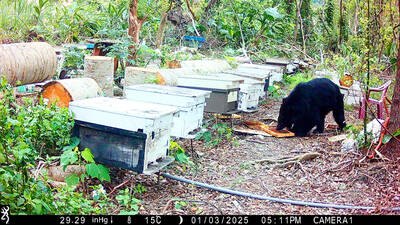A group of Aboriginal people who reside mainly in the border area between Hualien and Nantou counties were recognized yesterday as the Sediq, the country’s 14th distinct indigenous group.
At its regular weekly meeting, the Cabinet approved a proposal by the Council of Indigenous People to classify the Sediq as a separate group from the Atayal tribe.
Premier Chang Chun-hsiung (張俊雄) said that the approval was based on the spirit of “respecting the will of native people” and in accordance with the principle of “equality” enshrined in laws and regulations to guide the government’s Aboriginal policies.

PHOTO: CNA
“On behalf of the government, I hereby send my sincerest congratulations to the Sediq people on the restoration of their own tribe name,” Chang said.
Minister of the Council of Indigenous People Icyang Parod said the move would help the Sediq to “raise their self-identification and safeguard the tribe’s cultural heritage.”
The Sediq will have their own representatives on the council’s highest policy-making commission, Icyang said.
The council said there are about 6,000 to 7,000 Sediq.
The Japanese colonial government arbitrarily lumped together Aboriginal groups into “nine tribes” during its occupation of Taiwan, under which Taroko, Sediq and other groups were labeled as Sediq, a subgroup of the Atayal tribe.
The classification system was not challenged until the Democratic Progressive Party government came to power in 2000. It recognized the Tsao as the 10th tribe in 2001, followed by the recognition of the Kavalan, Taroko and the Sakizaya.
Ever since the recognition of the Taroko in January 2004, several negotiations had been held on whether the Sediq would agree to also use the name Taroko. But the discussions proved fruitless, as “both groups had been inconsistent on their specific names,” Icyang said.
The Sediq tribe filed an application with the council for recognition in April 2006.
The Cabinet decided to approve the recognition of the Sediq after a review committee under the direction of Minister-without-Portfolio Liu Yu-shan (劉玉山) concluded that the Sediq’s demand should be respected in accordance with the UN Declaration of Aboriginal Rights, Article 10 of the amendment to the Constitution and the Aboriginal Basic Law (原住民族基本法).
Wantan Diro, executive director of the Sediq Tribe Name Restoration Association, was excited yesterday by the Cabinet’s decision.
“Hallelujah! Thank God!” Watan said when asked by the Taipei Times for comment by telephone.
“I would like to thank Premier Chang for his decisiveness, the Council of Indigenous Peoples, the seven Aboriginal legislators and all the media organizations that have reported on our efforts [to gain recognition],” he said.
Wantan said that official recognition is not the end, but the beginning of another page in the tribe’s history.
“We will need to start organizing our tribal assembly, preparing for autonomy, building a tribal identity, and most importantly — revive, preserve and reform the Sediq language, culture, customs, sciences and education,” he said.
Wantan said that though several tribes have received official recognition in recent years, their people still do not feel attached to their new tribal identity.
“So we’re planning on a campaign with the goal to get at least 10,000 Sediqs to register themselves as Sediqs with the Household Registration Offices,” he said.
As for culture, Watan believed that, in addition to reviving and preserving the wisdom of the tribe’s ancestors, “we need to also reform some of it according to new technical or scientific developments and findings, so that our ancient knowledge won’t become outdated.”

SHIPS, TRAINS AND AUTOMOBILES: The ministry has announced changes to varied transportation industries taking effect soon, with a number of effects for passengers Beginning next month, the post office is canceling signature upon delivery and written inquiry services for international registered small packets in accordance with the new policy of the Universal Postal Union, the Ministry of Transportation and Communications said yesterday. The new policy does not apply to packets that are to be delivered to China, the ministry said. Senders of international registered small packets would receive a NT$10 rebate on postage if the packets are sent from Jan. 1 to March 31, it added. The ministry said that three other policies are also scheduled to take effect next month. International cruise ship operators

NUMBERS IMBALANCE: More than 4 million Taiwanese have visited China this year, while only about half a million Chinese have visited here Beijing has yet to respond to Taiwan’s requests for negotiation over matters related to the recovery of cross-strait tourism, the Tourism Administration said yesterday. Taiwan’s tourism authority issued the statement after Chinese-language daily the China Times reported yesterday that the government’s policy of banning group tours to China does not stop Taiwanese from visiting the country. As of October, more than 4.2 million had traveled to China this year, exceeding last year. Beijing estimated the number of Taiwanese tourists in China could reach 4.5 million this year. By contrast, only 500,000 Chinese tourists are expected in Taiwan, the report said. The report

The Forestry and Nature Conservation Agency yesterday launched a gift box to market honey “certified by a Formosan black bear” in appreciation of a beekeeper’s amicable interaction with a honey-thieving bear. Beekeeper Chih Ming-chen (池明鎮) in January inspected his bee farm in Hualien County’s Jhuosi Township (卓溪) and found that more than 20 beehives had been destroyed and many hives were eaten, with bear droppings and paw prints near the destroyed hives, the agency said. Chih returned to the farm to move the remaining beehives away that evening when he encountered a Formosan black bear only 20m away, the agency said. The bear

HORROR STORIES: One victim recounted not realizing they had been stabbed and seeing people bleeding, while another recalled breaking down in tears after fleeing A man on Friday died after he tried to fight the knife-wielding suspect who went on a stabbing spree near two of Taipei’s busiest metro stations, Taipei Mayor Chiang Wan-an (蔣萬安) said. The 57-year-old man, identified by his family name, Yu (余), encountered the suspect at Exit M7 of Taipei Main Station and immediately tried to stop him, but was fatally wounded and later died, Chiang said, calling the incident “heartbreaking.” Yu’s family would receive at least NT$5 million (US$158,584) in compensation through the Taipei Rapid Transit Corp’s (TRTC) insurance coverage, he said after convening an emergency security response meeting yesterday morning. National